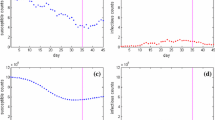Abstract
In stochastic modelling of infectious spread, it is often assumed that infection confers permanent immunity, a susceptible-infective-removed (SIR) model. We show how results concerning long-term (endemic) behaviour may be extended to a susceptible-infective-removed-susceptible (SIRS) model, in which immunity is temporary. Since the full SIRS model with demography is rather intractable, we also consider two simpler models: the susceptible-infective-susceptible (SIS) model with demography, in which there is no immunity; and the SIRS model in a closed population. For each model, we first analyse a deterministic model, then approximate the quasi-stationary distribution (equilibrium distribution conditional upon non-extinction of infection) using a moment closure technique. We look in particular at the effect of the immune period upon infection prevalence and upon time to fade-out of infection. Our main findings are that a shorter average immune period leads to higher infection prevalence in quasi-stationarity, and to longer persistence of infection in the population.
Similar content being viewed by others
References
Darroch J, Seneta E (1967) On quasi-stationary distributions in absorbing continuous-time finite Markov chains. J Appl Probab 4: 192–196
Doering CR, Sargsyan KV, Sander LM (2005) Extinction times for birth-death processes: exact results, continuum asymptotics, and the failure of the Fokker-Planck approximation. Multiscale Model Simul 3: 283–299
Gardiner GW (1985) Handbook of stochastic methods for physics, chemistry and the natural sciences, 2nd edn. Springer, Berlin
Hagenaars TJ, Donnelly CA, Ferguson NM (2004) Spatial heterogeneity and the persistence of infectious diseases. J Theor Biol 229: 349–359
Krishnarajah I, Cook A, Marion G, Gibson G (2005) Novel moment closure approximations in stochastic epidemics. Bull Math Biol 67: 855–873
Krishnarajah I, Cook A, Marion G, Gibson G (2008) Novel bivariate moment-closure applications. Math Biosci 208(2): 621–643
Kryscio RJ, Lefèvre C (1989) On the extinction of the SIS stochastic logistic epidemic. J Appl Probab 27: 685–694
Lloyd AL (2004) Estimating variability in models for recurrent epidemic: assessing the use of moment closure techniques. Theor Popul Biol 65: 59–71
Matis JH, Kiffe TR (1996) On approximating the moments of the equilibrium distribution of a stochastic logistic model. Biometrics 28(3): 980–991
Mendy ST (2009) Quasi-stationarity of stochastic models for the spread of infectious diseases. Ph.D. thesis, University of Liverpool, UK
Nåsell I (1996) The quasi-stationary distribution of the closed endemic SIS model. Adv Appl Probab 28: 895–932
Nåsell I (1999a) On the quasi-stationary distribution of the stochastic logistic epidemic. Math Biosci 156: 21–40
Nåsell I (1999b) On the time to extinction in recurrent epidemics. J R Stat Soc B 61: 309–330
Nåsell I (2003a) Moment closure and the stochastic logistic model. Theor Popul Biol 63: 159–168
Nåsell I (2003b) An extension of the moment closure method. Theor Popul Biol 64: 233–239
Nåsell I (2004) Cumulant equations for the classic endemic model. www.math.kth.se/~ingemar/forsk/endsir/endsir.html
Nåsell I (2005) A new look at the critical community size for childhood infections. Theor Popul Biol 67: 203–216
Ovaskainen O (2001) The quasistationary distribution of the stochastic logistic model. J Appl Probab 38: 898–907
Weiss GH, Dishon M (1971) On the asymptotic behaviour of the stochastic and deterministic models of an epidemic. Math Biosci 11: 261–265
Author information
Authors and Affiliations
Corresponding author
Rights and permissions
About this article
Cite this article
Clancy, D., Mendy, S.T. The effect of waning immunity on long-term behaviour of stochastic models for the spread of infection. J. Math. Biol. 61, 527–544 (2010). https://doi.org/10.1007/s00285-009-0313-4
Received:
Revised:
Published:
Issue Date:
DOI: https://doi.org/10.1007/s00285-009-0313-4
Keywords
- Quasi-stationary distribution
- Stochastic infection model
- Diffusion approximation
- Cumulant equations
- Moment closure




